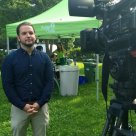A study released Tuesday reveals why people in some of Montreal’s more disadvantaged and multi-ethnic neighbourhoods were so heavily affected by COVID-19.

The researchers from SHERPA warn that if the government does not act, a possible second wave could have disastrous consequences for the city’s racialized people.
“Back during the confinement, it became apparent that there were that certain cultural communities that seemed to be particularly affected by the by the pandemic,” said researcher Janet Cleveland, who co-authored the report.
“Particularly those who were working in CHSLD as personal care attendants, so many refugee claimants, people from Haiti, from sub-Saharan Africa.”
After doing interviews with 50 informants from various communities, Cleveland and her team found that some of the factors that influenced COVID-19’s effect on cultural communities were being in tough financial situations, or having a high-risk front-line job.
“They tend to have lower incomes, so often, maybe, for example, will be living in smaller apartments with less ability to do distance,” she explained.
Other risk factors included having precarious migration status, lacking medical insurance, being an Allophone, having low literacy or being targeted by racism.
“People who recently arrived often were not able to either access information or to explain their symptoms if they called the help line for screening,” Cleveland told Global News.
Tiffany Callender, executive director of the Côte-des-Neiges Black Community Association, was not surprised by SHERPA’s findings at all.
“An overwhelming number of people living in poverty are people of color, and they have limited access to resources, opportunities and different employment opportunities,” she said.
“So it was obvious to us, clearly not obvious to the government.”
The government admitted it should have better communicated with the most vulnerable, and said it has now prepared COVID-19 information in more than 10 languages.
“I think we’re sensitive to that, and this is what we’ve learned from the first wave,” said Quebec Health Minister Christian Dubé.
“We understood that the people need to have a voice and paint their own portrait of how they’ve been socially and economically impacted by COVID-19,” Callender said.
The government is confident it will do better if there is a second wave.
“We are working a lot with municipalities to make sure that we don’t forget those communities which are at a higher risk,” said Dr. Horacio Arruda, Quebec’s public health director.
Callender and the researchers hope it’s not just talk. Callender said she hopes now that the SHERPA academics have shined a light on the racial disparities of COVID-19, the government will take stronger action.



Comments